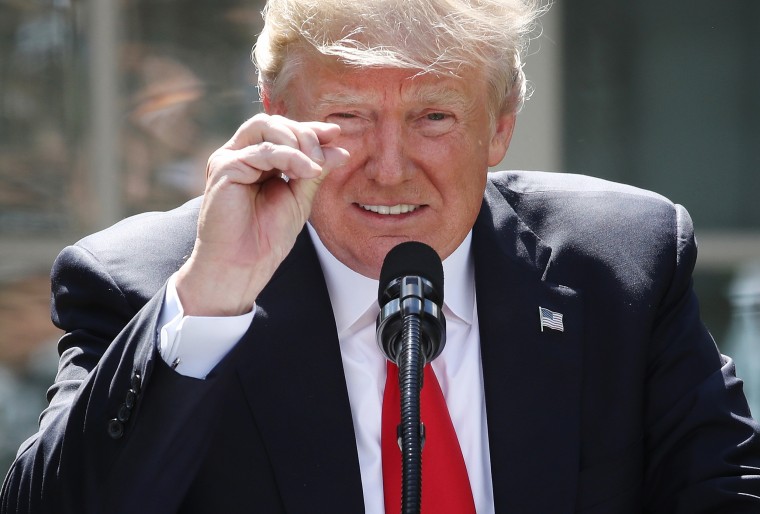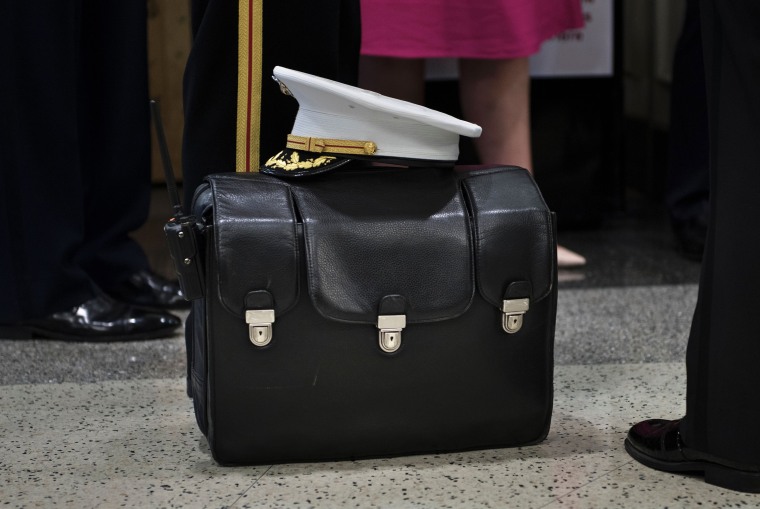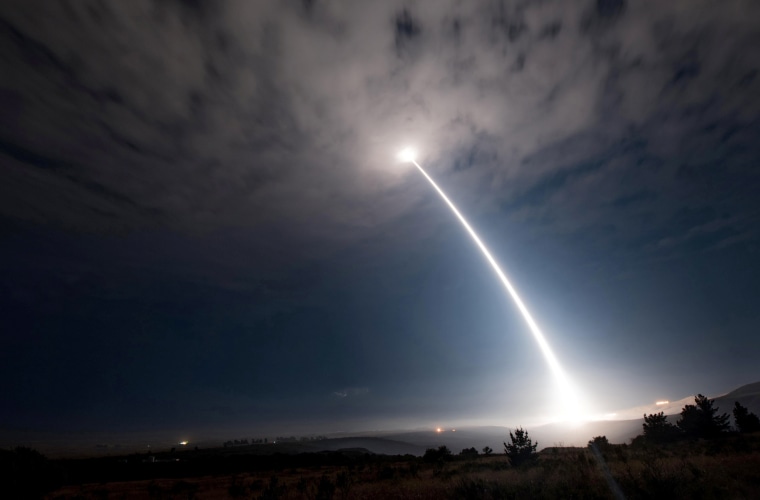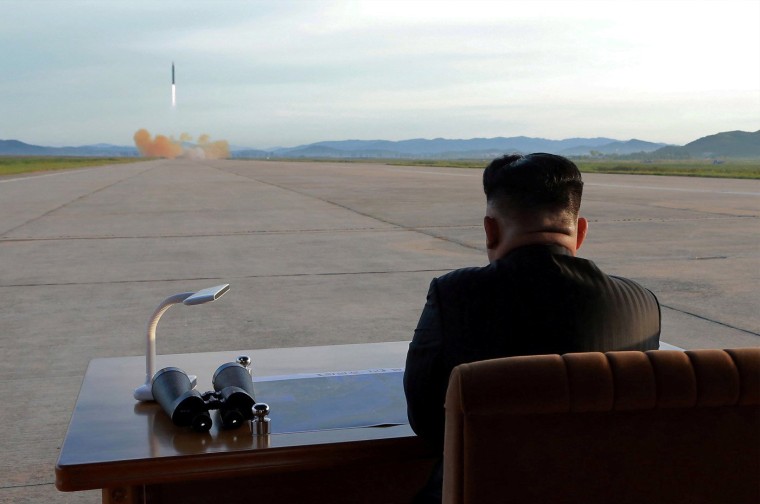President Donald Trump frequently lauds the U.S. military, has appointed generals to four key administration posts and regularly talks up the U.S. nuclear arsenal.
But does that mean he understands nuclear strategy — its aims, risks and costs? There are worrying signs that, when it comes to nukes, Trump is in way over his head.
During the presidential campaign he indicated he didn’t know what the nuclear triad was (it's the combination of air-, ground- and sea-launched atomic weapons) and NBC News just revealed that Trump expressed a desire for more weapons.
Tens of thousands more.
So it might not be so surprising that the president often talks about modernizing U.S. nuclear weapons. Which is not the key point. More reliability, not more power, is what matters most.
In August, the Pyongyang regime even threatened to lob ballistic missiles at the U.S. Pacific territory of Guam, prompting Trump to threaten back on Twitter: "My first order as president was to renovate and modernize our nuclear arsenal. It is now far stronger and more powerful than ever before."
It's safe to say the United States will not be adding tens of thousands of new atomic warheads. But are existing American nuclear weapons really “more powerful” and more modern than ever before, as Trump claimed? Just as important, is bigger even better in the context of nuclear warfare?
"The U.S. arsenal is pretty much the same today as it was when Trump took office," Hans M. Kristensen, the director of the Nuclear Information Project at the Federation of American Scientists, told NBC News.

Nuclear modernization in fact, looks to be low on this administration's priorities — particularly when compared with the emphasis Trump's predecessor, Barack Obama, placed on it.
True, Trump did order a formal Nuclear Posture Review — the customary assessment of the nation's atomic weaponry issued by incoming presidents. He signed it on Jan. 27, a week into his presidency. But Trump had already issued 10 major executive orders by then.
More important, however, Trump’s tweet misses the key point when it comes to nukes: To make nuclear weapons more effective, you make them more “reliable” — not more powerful.
Indeed, the current stand-off with North Korea is a good example of why reliability is more important than size and power. Kim, with his estimated 60 (or fewer) small nukes, is facing off against Washington, with its far more numerous, and far larger, nukes. (According to the Federation of American Scientists, the U.S. has approximately 6,800 total nuclear warheads in its arsenal, including nondeployed and retired weapons. By February 2018, U.S.-deployed warheads should number 1,550.)
At least for the moment, Kim is holding his own.
“You want other actors to believe that you have reliable equipment that will launch when you push the proverbial red button," Will Saetren, a nuclear weapons policy specialist at the Institute for China-America Studies, a Washington-based think tank, said. "But as North Korea is effectively demonstrating, it takes far less than 1,550 nuclear weapons to achieve that goal."
America's nuclear weaponry does need upkeep, however. It is, on average, more than 30 years old. The electronics are obsolete. Wiring is fraying. Rocket motors are losing their chemical potency. The Pentagon’s estimated $1 trillion modernization effort, which began under Obama, is replacing the aging warheads as well as the rockets, missiles, submarines, bombers and jet fighters that deliver them.

Rather than trying to pack more punch into each warhead, however, the modernization effort aims to preserve — and slowly shrink — America's nuclear arsenal, while ensuring it is viable for decades to come. As Cmdr. Linda Rojas, a Pentagon spokeswoman, said, “Modernization of U.S. nuclear weapons and delivery platforms is critical to ensure our ability to maintain an effective deterrent.”
Upkeep on existing nukes, Rojas said, costs up to $14 billion per year. Building new warheads and the rockets, subs and planes to deliver them could cost an additional $300 billion through 2040, she added. Yet the U.S. atomic arsenal in August 2017 was smaller than it was under Obama — and, by design, is getting smaller still.
Washington is acting under the New Strategic Arms Reduction Treaty (START) that the Obama administration signed with Russia in 2010. It requires both countries to cut their deployed strategic warheads by 10 percent, down to 1,550 in 2018. Trump has already complicated efforts for further nuclear negotiation with the Kremlin, however, after reportedly telling Russian President Vladimir Putin in February that the treaty was a bad deal for the United States.
While the U.S. military is designing new nuclear weapons models, some of which were greenlighted by Obama, the goal is still to “reduce the size of the arsenal by an additional 30 percent,” Saetren said, “down to 1,000 deployed nuclear warheads."

This brings us back to a nuclear weapon’s crucial, if narrow, function of deterrence — a function Trump’s other comments on the topic suggest he does not fully value. No one actually benefits from atomic warfare. This means most nuclear weapons essentially serve as bluffs.
This is also why the size of a country's atomic arsenal is largely academic. A hundred world-destroying warheads can deter a nuclear-armed enemy as well as a thousand warheads can.
"Look at North Korea," Saetren said. "They have an estimated arsenal of 60 first-generation warheads, none of which are hydrogen bombs, and very crude, if any, delivery vehicles.”
Yet, North Korea has succeeded in deterring the United States from taking military action — a point that Steve Bannon, then Trump's strategic adviser, underscored in an August interview with The American Prospect.
“There’s no military solution” to North Korea’s nuclear threats, Bannon said. “Forget it."
Saetren said that Bannon admitted that North Korea had "succeeded in deterring the United States, the most powerful nuclear weapons state in the world."
"That should tell you something about deterrence," Saetren said.
"Nuclear arsenals are essentially big scary illusions that can scare an enemy off and deter attack, but in reality, they are useless," he added. "Once an actor deploys his nukes, the game is already lost.”
If Trump fully understood nuclear deterrence, he would be tweeting about the reliability of America’s nuclear arsenal, not its power. And he certainly wouldn't be demanding a massive expansion of the country's atomic arsenal.
David Axe has written about the U.S. military for The Daily Beast, Vice, Reuters and other publications. He edits War Is Boring, a military news website.
